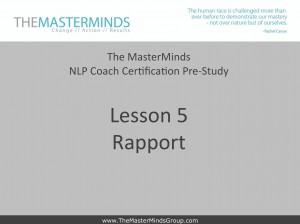Welcome to The MasterMinds NLP Tutorials Lesson 5 on rapport.
Rapport is THE technique that will get you what you want, full stop.
It is crucial to establish trust.
Study this very closely, we’ll practice this a lot during the course, but you need to REALLY understand the theory behind it.
Then, start practicing RIGHT AFTER you have watched the video, and see the results. Also email or post comment below if you have any experience to share or a question.
ASSIGNMENT: Before you come to the training, do an exercise in Matching & Mirroring, at work, with friends, in public transport or public places, at restaurants, counters etc… Practice for a week 15mn (or more) a day. Then write a 1 page essay on your conclusions: what you did, what worked and what did not, what will you do next time, new ideas and possibilities for using rapport.
NB: some NLP jargon you want to remember.
– Matching: when you match with your physiology, tonality or words the physiology, tonality or words of the person in front of you (example: they raise their left hand, you raise you left hand as well).
– Mirroring: when you move your body in a way that it reflects the physiology of the person you want to establish rapport with, as if he/she was seeing himself/herself in a mirror (example: they raise their left hand, you raise your right).
– Cross-over mirroring: when you match or mirror the person’s physiology with another part of your body (example: they tap their foot, you tap your fingers).
WATCH OUT: matching and mirroring are NOT copying, watch the video to know more.

A very practical example of how rapport can make a REAL difference. An article on how an FBI agent gets a terror suspect to talk without torture.
Rapport – Ali Soufan Article
Also read this article from the Harvard Business School ‘Decoding insiders information and other secrets of old school chums‘ that details how it’s possible to make better stock picks simply by knowing whether two industry players went to the same college or university. The authors study how social connections affect important decisions and, ultimately, how those connections help shape the economy. The impact of rapport goes well beyond the confines of polite conversation.
Hi Helene – interesting module. I thought the 55/38/7 research was done by Alfred Mehrabian, though, as part of his 1967 research about what makes people like us (as opposed to general communication). Here is a link: http://en.wikipedia.org/wiki/Albert_Mehrabian
Be interested in your thoughts?
Marina
Hi Marina, Yes, the 55/38/7 rule comes from Mehrabian, Birdwhistell is the originator of Kinesics, the general study of non-verbal behaviour. Since big picture, Rapport is about non verbal communication, I mentioned Birdwhistell, but I’ll amend the video to be more accurate.
Cool.
loved the lesson 5 on rapport…found it amazingly interesting that only 7% of communication is thru words! tasha
Yes Tasha. We usually believe our words carry much more weight than they actually do.
Hi Helen,
Thank you for sharing the articles. I found the Harvard Business School article particularly interesting, because it worked. As for the FBI link, it doesn’t work, so I don’t find it as interesting. Just thought I’d let you know.
Cheers,
Lucas
Hi Lucas,
Try again, the Newsweek article on Ali Soufan should work now.